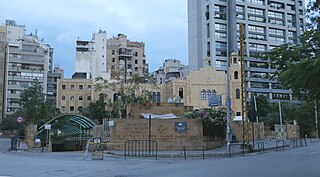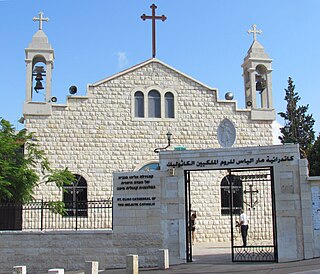
The Melkite Catholic Patriarchate of Antioch is the only actual residential Patriarchate of the Melkite Greek Catholic Church. It was formed in 1724 when a portion of the Orthodox Church of Antioch went into communion with Rome, becoming an Eastern Catholic Church, while the rest of the ancient Patriarchate continues in full communion with the rest of the Eastern Orthodox Church.
Euthymius Fadel of Ma’loula was bishop of Zahle and Forzol of the Melkite Greek Catholic Church and took a preeminent part in the 1724 split of the Melkite Church.

The Archeparchy of Beirut and Byblos is a metropolitan eparchy of the Melkite Greek Catholic Church since 1881, an Eastern Catholic church in communion with the Roman Catholic Church. Located in Lebanon, it includes the cities of Beirut and Byblos, and in terms of population, it is the largest Melkite eparchy in the Middle East. Its current Eparch, Georges Wadih Bacouni, S.M.S.P., was elected in November 2018.

Melkite Greek Catholic Archeparchy of Akka is an Eastern Catholic diocese of Melkite Greek Catholic Church, directly subject to the Melkite Catholic Patriarchate of Antioch. Its Cathedral episcopal see is St. Elijah Greek-Melkite Cathedral, in Haifa.
Philippe Nabaa was Archeparch of the Melkite Greek Catholic Archeparchy of Beirut and Byblos.
Issam John Darwich, BS, was Archbishop of the Melkite Greek Catholic Archeparchy of Zahle and Forzol in Lebanon from 2011 to 2021.
Georges Nicolas Haddad, SMSP is the current bishop of the Melkite Greek Catholic Archeparchy of Baniyas, Lebanon.
Jean-Abdo Arbach, B.C., is the current archeparch of the Melkite Greek Catholic Archeparchy of Homs, Hama and Yabroud.
Melkite Greek Catholic Archeparchy of Baniyas is a diocese of the Melkite Greek Catholic Church suffragan of the Melkite Greek Catholic Archeparchy of Tyre. In 2009 there were 2,500 baptized. It is currently governed by Archeparch Georges Nicholas Haddad, SMSP. The Archeparchy is named after the city of Baniyas in the Golan Heights at the foot of Mount Hermon.
Melkite Greek Catholic Archeparchy of Bosra and Hauran is an archeparchy of the Melkite Greek Catholic Church with its territory located in Syria. It is currently governed by Archeparch Nicolas Antiba, BA.

Melkite Greek Catholic Archeparchy of Aleppo is an archeparchy of the Melkite Greek Catholic Church located in Syria, based in Aleppo. Its current archeparch is Jean-Clément Jeanbart.
Melkite Greek Catholic Archeparchy of Tripoli is a diocese of the Melkite Greek Catholic Church suffragan of the Melkite Greek Catholic Archeparchy of Tyre. It is governed by Archeparch Eduard Daher, BC.
Eduard Georges Daher, B.C., is the current Melkite Greek Catholic Archbishop of the Melkite Greek Catholic Archeparchy of Tripoli.
Augustin Farah was an archbishop of the Melkite Greek Catholic Archeparchy of Tripoli and the Melkite Greek Catholic Archeparchy of Zahle and Forzol.
Melkite Greek Catholic Archeparchy of Sidon is a diocese of the Melkite Greek Catholic Church suffragan of the Melkite Greek Catholic Archeparchy of Tyre. It is governed by Archeparch Elie Bechara Haddad. The territory is made up of 53 parishes and, as of 2010, 32,000 Melkite Catholics.
André Haddad, BS was an archbishop of the Melkite Greek Catholic Archeparchy of Zahle and Forzol.
Melkite Greek Catholic Archeparchy of Homs is a nominally Metropolitan Archeparchy of the Melkite Greek Catholic Church in central Syria. It was established on March 4, 1849 and has no suffragan, but two merged-in eparchial titles.
Ambroise Abdo was a bishop of the Melkite Greek Catholic Archeparchy of Jerusalem and Melkite Greek Catholic Archeparchy of Zahle and Forzol.
Georges Scandar was the first eparch of the Maronite Catholic Eparchy of Zahleh and a former eparch of the Maronite Catholic Eparchy of Baalbek and Zahleh.




